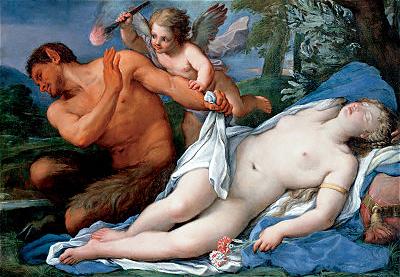EROS REVEALING A SLEEPING VENUS TO A BASHFUL SATYR
SN 163, oil on canvas, c. 1720Giuseppe Bartolomeo Chiari
Italian, 1654-1727
ARTIST:
Chiari was born in March of 1654, but it’s not certain whether in Lucca or Rome. He
was a successful frescoist as well as painter.
From: "The Pages"
Young Giuseppe was apprenticed at the age of 10 to a painter and art dealer, Carlantonio
Galliani, but joined Carlo Maratti’s studio in Rome two years later, in 1666. He was
Maratti’s most faithful pupil, keeping his art alive into the 1720s with a softer,
more elegant version of his classicism. His first official commission was for paintings on
the side walls of the chapel of the Marcaccioni in Santa Maria del Suffragio, Rome. |
|
 |
This project established his reputation; thereafter he won the patronage of many noble
Roman families and of foreign visitors to Rome. In the early years of the 18th c, Pope
Clement XI became Chiari’s most important patron. The Graf Christian Schaumburg-Lippe
of Germany, also snapped up Chiari’s paintings.
He painted predominantly religious works, although he also did some fine cabinet pieces of
mythologic scenes. Chiari was made Principe of the Accademia di S Luca, Rome, from 1722 to
1725.
SUBJECT:
The scene is one drawn from mythology. There are three characters: Venus is asleep in the
woods. She is the goddess of love, and unlike the other Olympians, she was charged with
only one duty – to incite desire. As the goddess of love, she enters more legends
than any other god or goddess. She bore many children, among them Eros, the archer of
love. His father was Jupiter (Zeus). Here, Eros is carrying the torch and revealing the
goddess to the satyr, who tries to turn away from Eros’ teasing. Satyrs were
goat-footed and horned woodland dieties, descendants of Pan and followers of Dionysus, god
of the vine.
PAINTING:
The painting is full of lush color and movement, a good example of the elegant classicism
of which Chiari was capable.
Museum Label:
Eros Revealing a Sleeping Venus to a Bashful Satyr
c. 1720
Artist: Giuseppe Bartolomeo Chiari
Italian, 1654-1727, active in Rome
Oil on canvas, 44 1/8 x 63 3/8 in. (112.1 x 161 cm)
In this sumptuous rendering of a familiar mythological passage, Cupid uses his torch to
inflame the reticent satyr to act on his desire. The satyr is apprehensive at the sight of
Venus in her recumbent repose, but Eros is inescapable. Though Chiari's palette and
brushwork possess a Rococo veneer, the monumentality and idealization of the figures
reiterate the classic poses of the Renaissance. Following in the shadow of his famous
teacher, Carlo Maratti, Chiari established himself in Rome where he was favored with many
noble patrons.
Bequest of John Ringling, 1936, SN163
ringlingdocents.org
|
